|

“Almost like a real web
site”
|
IN7OMM.COM
• Search |
Contact
• News |
e-News |
• Rumour Mill |
Stories
• Foreign Language
• in70mm.com auf Deutsch
WHAT'S ON IN 7OMM?
7OMM FESTIVAL
• Todd-AO Festival
• KRRR! 7OMM Seminar
• GIFF 70, Gentofte
• Oslo 7OMM Festival
• Widescreen Weekend
TODD-AO
• Premiere |
Films
• People |
Equipment
• Library |
Cinemas
• Todd-AO Projector
• Distortion Correcting
PANAVISION
• Ultra Panavision
70
• Super Panavision
70
|
 |
|
VISION, SCOPE & RAMA
1926
Natural Vision
1929 Grandeur
1930 Magnifilm
1930 Realife
1930 Vitascope
1952 Cinerama
1953
CinemaScope
1955 Todd-AO
1955 Circle Vision
360
1956
CinemaScope 55
1957 Ultra
Panavision 70
1958 Cinemiracle
1958 Kinopanorama
1959 Super
Panavision 70
1959 Super Technirama 70
1960 Smell-O-Vision
1961 Sovscope
70
1962
Cinerama 360
1962 MCS-70
1963 70mm Blow Up
1963 Circarama
1963 Circlorama
1966 Dimension 150
1966
Stereo-70
1967 DEFA 70
1967 Pik-A-Movie
1970 IMAX / Omnimax
1974 Cinema
180
1974 SENSURROUND
1976 Dolby Stereo
1984 Showscan
1984 Swissorama
1986 iWERKS
1989 ARRI 765
1990 CDS
1994 DTS / Datasat
2001
Super Dimension 70
2018 Magellan 65
•
Various Large format
| 70mm to 3-strip |
3-strip to 70mm |
Specialty Large Format |
Special Effects in 65mm |
ARC-120 |
Super Dimension 70
| Early Large Format
• 7OMM Premiere in
Chronological Order
7OMM FILM & CINEMA
• Australia |
Brazil
• Canada |
Denmark
• England |
France
• Germany |
Iran
• Mexico |
Norway
• Sweden |
Turkey
• USA
LIBRARY
• 7OMM Projectors
• People |
Eulogy
• 65mm/70mm Workshop
• The 7OMM Newsletter
• Back issue |
PDF
• Academy of the WSW
7OMM NEWS
• 2026 | 2025 | 2024
• 2023 |
2022 |
2021
• 2020 |
2019 |
2018
• 2017 |
2016 |
2015
• 2014 |
2013 |
2012
• 2011 |
2010 | 2009
• 2008 | 2007 |
2006
• 2005 | 2004 |
2003
• 2002 |
2001 |
2000
• 1999 |
1998 |
1997
• 1996 |
1995 |
1994
|
|
in70mm.com Mission:
• To record the history of the large format movies and the 70mm cinemas
as remembered by the people who worked with the films. Both during
making and during running the films in projection rooms and as the
audience, looking at the curved screen.
•
in70mm.com, a unique internet based magazine, with articles about 70mm
cinemas, 70mm people, 70mm films, 70mm sound, 70mm film credits, 70mm
history and 70mm technology. Readers and fans of 70mm are always welcome
to contribute.
•
Disclaimer |
Updates
• Support us
• Testimonials
• Table of Content
|
| |
| |
Extracts and longer
parts of in70mm.com may be reprinted with the written permission from
the editor.
Copyright © 1800 - 2070. All rights reserved.
Visit biografmuseet.dk about Danish cinemas

|
| |
Radio City Music Hall
70mm Film Presentations
|
This article first appeared in
..in 70mm
The 70mm Newsletter |
|
Written by:
Mr. Bob Endres, Chief projectionist at The Hall.
Pictures by: Thomas Hauerslev |
Issue 58 - September 1999 |
|
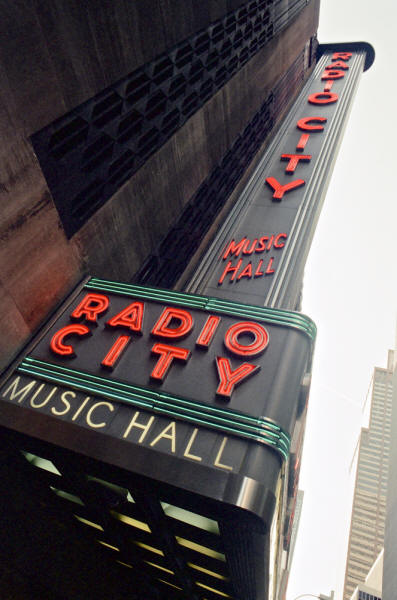 The
Radio City Music Hall front view with neon letters. From the streets around
Rockefeller Center in New York City. The
Radio City Music Hall front view with neon letters. From the streets around
Rockefeller Center in New York City.
Radio City Music Hall was conceived as part of the Rockefeller Center real estate complex in New York City during the height of the depression in the late Twenties. It opened on December 27, 1932 and is one of the largest theatres in the world, seating about 5900 people. (The seating varies from attraction to attraction depending on the amount of space needed for sound and light consoles and whether or not "pit seating" or seating in the orchestra pit area is employed). When it opened it was to be overseen by Samuel L. Rothafel
(or "Roxy"), who had operated a number of theatres in New York, including
the one that bore his name.
• Go to gallery Radio City Music Hall, New York
City, USA
The Hall was to present large vaudeville shows and its sister theatre, the
smaller New Roxy, was to combine vaudeville and motion pictures.
Unfortunately, the opening night attraction ran so long, the fear arose that
running stage attractions alone would result in financial failure.
So on January 11, 1933 the Hall ran its first feature film,
"The Bitter Tea of General Yen", directed by Frank Capra and starring Barbara Stanwyck, along with a stage show produced by the Roxy organization. The movie/stage show policy would last for almost forty-six years, until 1979, when the theatre stopped showing films on a regular basis and instead became a concert venue and a setting for a variety of telecasts such as the Grammy and MTV awards presentations. Today Radio City Productions which operates and leases the house is owned by Cablevision,
which also operates Madison Square Garden and owns a variety of sports teams, cable channels such as American Movie Classics and Bravo, widely carried on U.S. cable television systems (some of which they also own).
The Hall still serves as a premiere house, and was the site of the World Premiere of Disney's
"The Lion King" as well as an initial run of the film with a Disney-produced stage show. Other recent premieres have included the re-make of
"101 Dalmatians" and "GoldenEye" as well as the re-make of "Miracle on 34th
Street". In the case of "The Lion King", "101 Dalmatians" and
"Miracle on 34th Street", 70mm prints were made for Music Hall presentation.
|
Further in 70mm reading:
Gallery Radio City Music Hall, New York
City, USA
A Nostalgic View of
70mm in New York City - 1950-1970
The Rivoli Theatre
This is Oyster Bay
70mm Cinemas in
North America
Internet link:
Robert
Endres
|
|
 Side
view of the 5900 seats. Projection portholes are in upper left corner. Side
view of the 5900 seats. Projection portholes are in upper left corner.
The Hall was relatively late in installing 70mm projection equipment because of the necessity of accommodating the stage show that accompanied the film. The Music Hall show always ran between two and three hours including the stage show, which varied in length depending on the length of the feature. Since the initial 70mm attractions were all roadshow presentations, it was felt that they were too long to be played at the Hall.
By the time MGM wanted to play
"The Unsinkable Molly Brown" at the Hall in 70mm in 1964, roadshows were waning in popularity and some were predicting the demise of the 70mm format. So
"The Unsinkable Molly Brown" ran in 35mm. Then in 1970 Ross Hunter, the producer of
"Airport" insisted that film be shown at the Hall in 70mm. It was
decided to install three 70/35mm Simplex projectors and the associated sound
equipment. The selection of the Simplex projectors was made because the Hall
already had four Simplex X-L projectors in the booth, and most of the parts
were interchangeable.
|
|
|
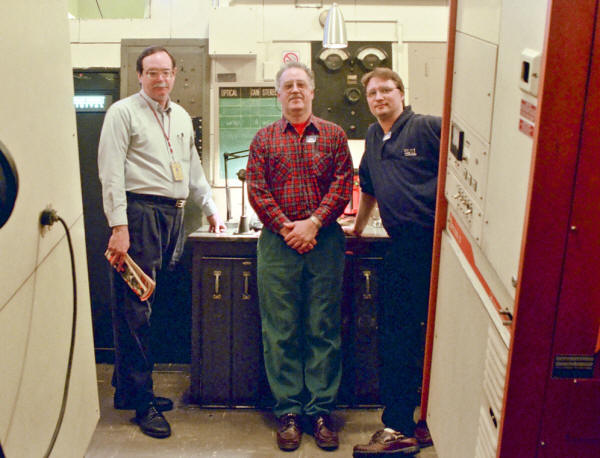 The
Hall Chief Projectionist Bob
Endres, Dennis Furbush and Thomas Hauerslev. The
Hall Chief Projectionist Bob
Endres, Dennis Furbush and Thomas Hauerslev.
In addition, the special aperture plates used to mask projected images to
fit scenery of the stage shows could be used in the 35/70 machines. Since
the Hall always had three projectors set up to run the feature, an extra
35mm machine was installed at that time, bringing the total projectors in
the booth to five. The two 35mm-only machines were used for coming
attractions, short subjects and the previously mentioned "film effects" or
scenic film projections used in the stage show. The Hall was to run two
other 70mm features that year -- "Darling
Lili" with Julie Andrews and
"Scrooge" with Albert Finney.
Since 1970 approximately twenty-two titles have had 70mm presentation at the Hall, either as part of the movie/stage show policy or as premieres and special presentations, and a 70mm print is used as the opening film sequence in the current edition of the Hall's annual Christmas Show. Ironically, by 1975 it was decided that it might be possible to re-run some of the initial roadshow 70mm releases and combine them with the Music Hall stage show, so the 70mm prints of
"Gone With The Wind",
"2001: A Space Odyssey", "Doctor Zhivago" and
"The Sound of Music" were all presented as reissues.
|
|
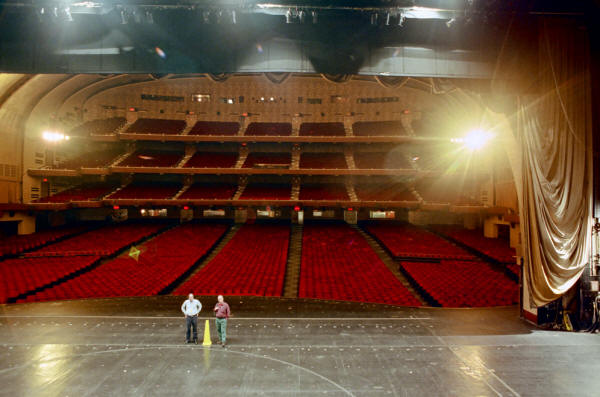 View
from the stage towards the auditorium. Picture taken from the
behind-the-screen projection booth. Note two people on the stage. View
from the stage towards the auditorium. Picture taken from the
behind-the-screen projection booth. Note two people on the stage.
For the 1994 presentation of "The Lion King" a completely new sound system was installed. It features a Dolby CP-200 processor, QSC power amplifiers and JBL speakers. Each of the five bi-amped stage channels includes four low-frequency JBL speaker cabinets and three high-frequency horns. There are eight dual sub-woofer cabinets and 98 surround speakers. The surround speakers are positioned at the front of the first mezzanine to cover the middle of the orchestra, as well as on the side walls and rear of the orchestra and each of the three mezzanines above it.
In addition to the surround delay built into the Dolby CP-200, two Audio Digital digital signal processors are incorporated to allow for four delay zones for the surrounds, which are divided into left and right banks. Total
watt power output from the QSC amps is about 46,000 watts.
The screen, or "picture sheet" at the Hall is 691/2´ x 341/2´ (21,2 x 10,5 m) and the full aspect ratio 70mm picture is 69´ x 31´ (21 x 9,4 m). The 1.85 70mm picture when run at maximum size is 63´ x 34´ (19,2 x 10,4 m). Because of the downward projection angle and the block-wide width of the house a matte white screen is used to avoid hot-spotting of the light. The lamphouses are made by Optical Radiation Co. and use 5,000 watt bulbs.
|
|
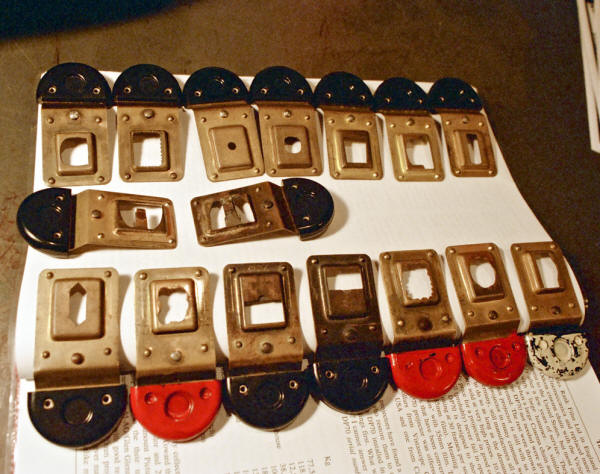 Bob Endres uses a lot of different masking plates to meet costumer demands on the screen. Bob Endres uses a lot of different masking plates to meet costumer demands on the screen.
The size of the auditorium presents a number of unique projection problems. Often prints are tailored to the theatre. This usually means printing them a little lighter in density to increase the apparent light on the screen. Since the projection throw is about 185´ to the screen, if the sound is in sync with the picture at the screen it is four frames out of sync at the back of the third mezzanine. If a 70mm print is being made for the Hall, the track is advanced one or two frames to put the sync point closer to the middle of the orchestra. (While the track can be advanced one frame in threading, if the loop between upper projector sprocket and the gate is made too big, the film becomes noisy and unstable -- thus it is preferable to have the track advanced in the recording process.)
When Disney came in to look at test reels prior to the premiere of "The Lion
King", we were able to run 70mm and 35mm reels of "Aladdin" locked together. It became obvious that the 35mm 1.85:1 picture size of 48´ x 26´ (14,6 x 7,9 m) couldn't compare with the larger image
made possible by 70mm., but Disney still wanted to use the Dolby Digital track on the 35mm film, so it was decided to install platters, the widely used horizontal film handling units found in most cinemas today, at the number 4 projector (70mm) and number 5 projector (35mm) and lock the two machines together. We employed selsyns -- the devices used to electrically tie projectors together in the 3-D days of the 1950's -- to provide frame-for-frame synch. The 70mm machine would supply the picture (although the film also carried the usual magnetic stripes which were sounded and encoded in Dolby SR) and the 35mm Simplex X-L was equipped with a Dolby Digital reader and supplied the sound from a normal Dolby SR.D print. For the premiere, a second 70mm print was run "reel to reel" as a backup on the other two 70mm projectors in the booth. Although we didn't see the second 70mm print after the premiere, the rest of the run of
"The Lion King" used the two projectors locked together. The same technique was used when Disney did the premiere of
"101 Dalmatians" in 1996.
|
|
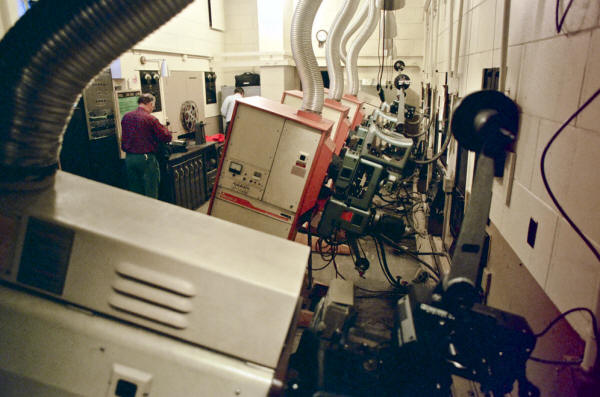 The
five projectors of The Hall, Simplex X-L's and Simplex 35/70's. The
five projectors of The Hall, Simplex X-L's and Simplex 35/70's.
One of the more unusual 70mm applications at the Hall was the presentation of the French production of
"Jesus Was His Name", a staging of the story of Christ told with live actors working below and in front of a large 78´ x 26´ (22,3 x 10 m) screen which carried a 70mm image both as scenic background and with actors integrated into the presentation. A special projection cabin was installed in the Orchestra of the Hall. The presentation used two Philips
DP-75 projectors with 10,000 watt lamphouses. Two prints were run simultaneously, one as backup, from platters at 30 frames per second. While the film tracks carried some of the show sound, the projectors were locked to digital tape decks both by shaft encoders and by time code on the film mag tracks. The performers wore receivers which received cues to enable them to interact with the picture. The language of the presentation could be changed by changing the digital tape which was locked to the film. The use of the 30 f.p.s. film speed (not generally seen since the early
Todd-AO presentations) enabled the larger wattage lamps to be used. The digital inter-locking to integrate live and film action made a technically fascinating interesting production.
The opening film effect in the annual Christmas Spectacular is a 70mm clip of footage re-edited from
"Santa Claus: The Movie" and also uses a special screen. We were asked to make the image as big as possible, so we run it on a 33´x 73´ screen hung downstage of our normal picture sheet.
In order to increase the light for the larger image, the screen doesn't have
the normal perforations used in screens when sound films are projected, thus
gaining us about 8% more light.
The
sound accompanying the images of Santa flying over New York in his sleigh is
provided by our orchestra playing an overture. The final images are of Santa
flying through Rockefeller Center and landing on the roof (supposedly) of the Music Hall. As the sleigh crosses the roof on film the screen flies out to reveal a live Santa crossing a set of the roof on our stage.
While the Hall was late installing 70mm equipment, it has proven to be the best and most impressive film format for the theatre. While watching a 35mm print in a 1.85 aspect ratio, the smallest image we project, is quite acceptable, it is obvious that it is well worth the trouble and expense to use 70mm for the most impact.
|
|
| |
|
Go: back
- top - back issues
Updated
21-01-24 |
|
|
 View
from the stage towards the auditorium. Picture taken from the
behind-the-screen projection booth. Note two people on the stage.
View
from the stage towards the auditorium. Picture taken from the
behind-the-screen projection booth. Note two people on the stage.  Bob Endres uses a lot of different masking plates to meet costumer demands on the screen.
Bob Endres uses a lot of different masking plates to meet costumer demands on the screen.
 The
five projectors of The Hall, Simplex X-L's and Simplex 35/70's.
The
five projectors of The Hall, Simplex X-L's and Simplex 35/70's.


